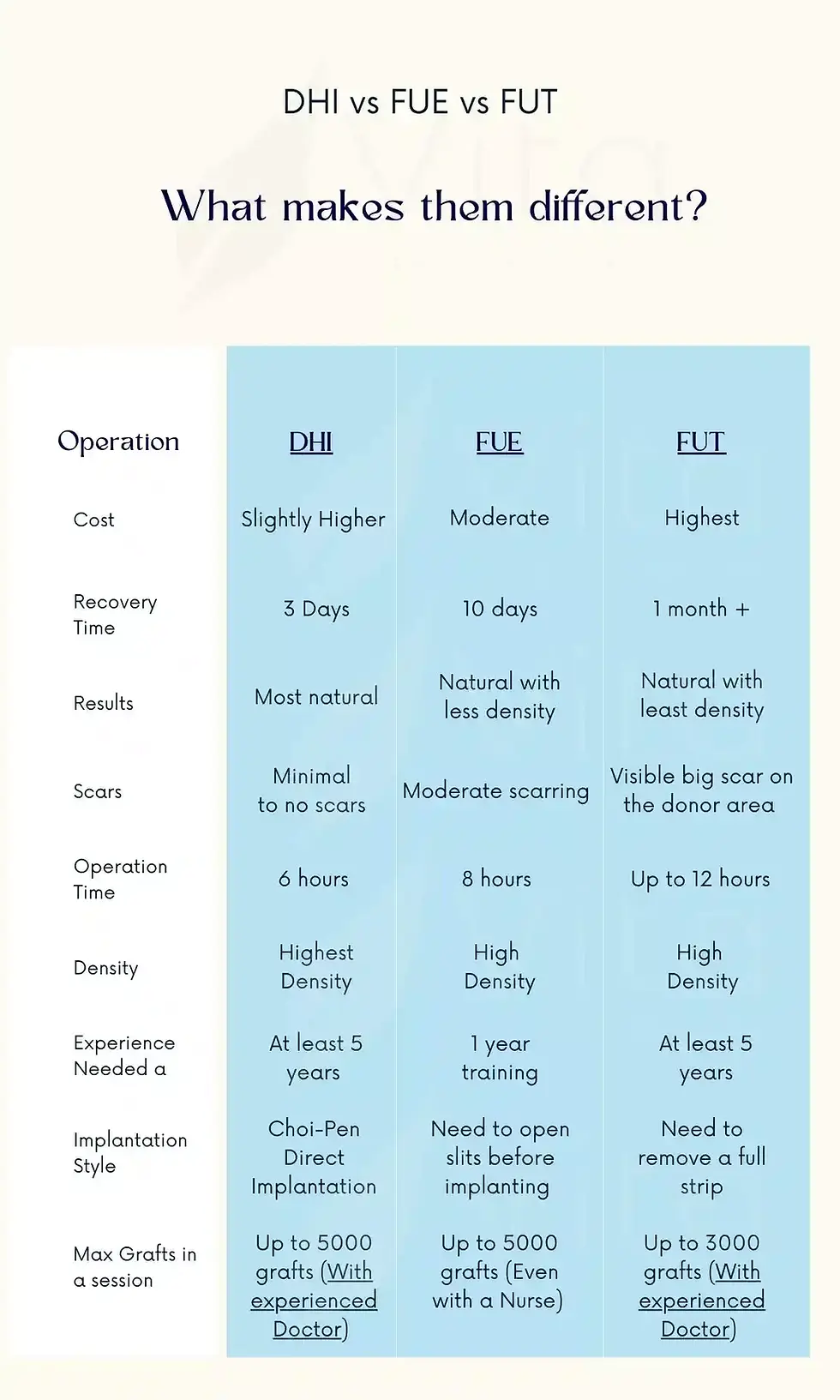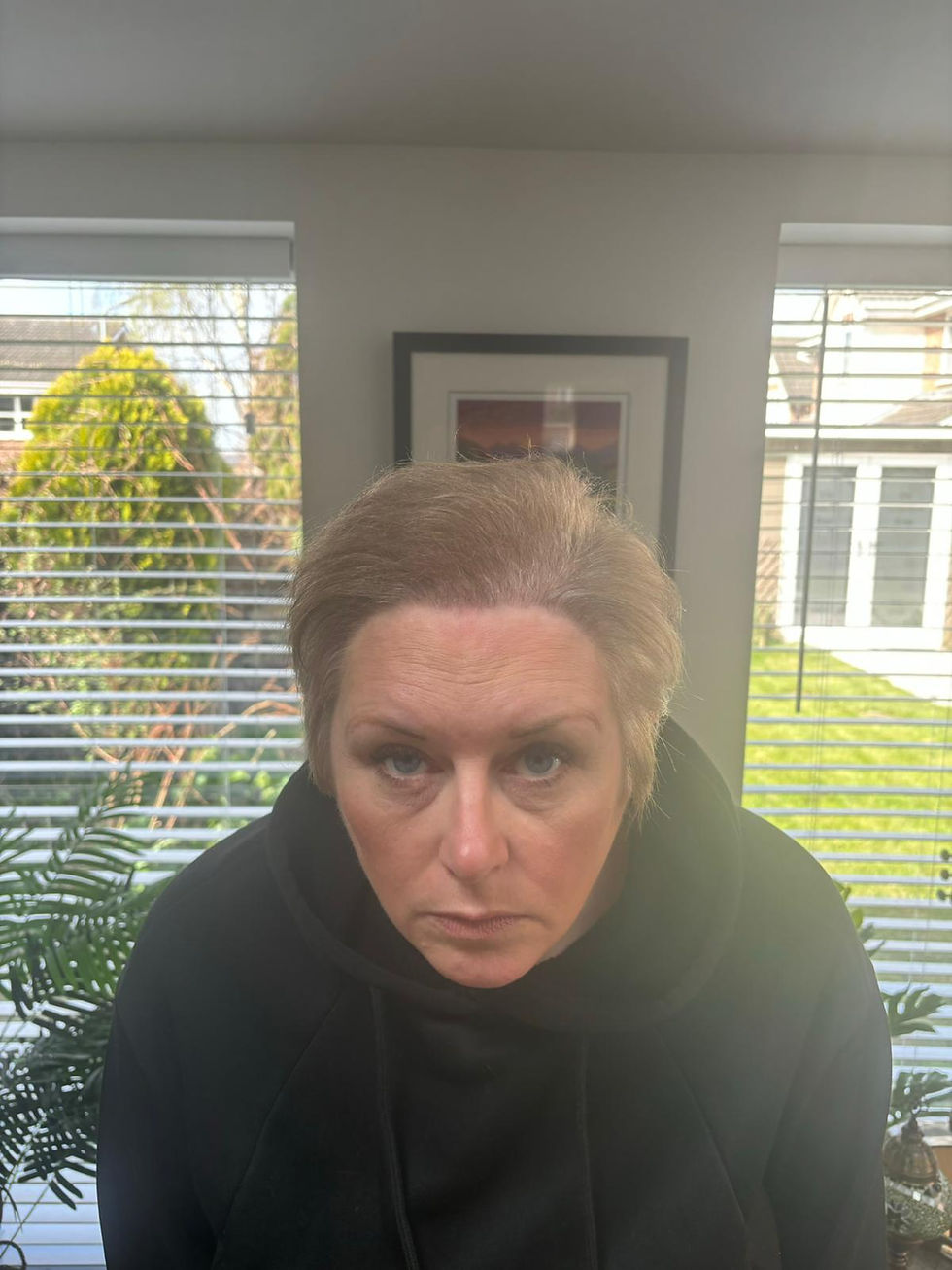DHI Hair Transplant in Turkey
- Vita Hair Clinic

- Jun 17
- 13 min read
Updated: Jul 28

Overview
Over 85 percent of men suffer from hair thinning before the age of 50. Additionally, around fifty percent of women deal with hair loss during their lifetime.
An effective treatment for this issue is DHI hair transplant in Turkey. Follicular unit transplantation (FUT) and Follicular Unit Extraction (FUE) are two of the most commonly used methods.
During FUT, your surgeon will cut a hair strip from the back of your scalp and extracts the hair follicles. In FUE, the surgeon removes hair follicles straight off your head.
In both procedures, the follicles get inserted into hairless regions on the scalp.
Direct hair implant (DHI) is a variation of the FUE technology developed by the firm DHI Global Medical Group.
When you undergo FUE surgery, the surgeon creates channels in the scalp before inserting the hair follicles. On the other hand, DHI uses a pen-shaped instrument, which can serve both purposes simultaneously. 1
In this comprehensive guide, we will cover everything you need to know about DHI hair transplant in Turkey to help restore your hair.
How do direct hair transplants work?

Since DHI is a variation of FUE, it follows similar steps.
Your surgeon will collect follicles from your donor area and implant these follicles in the balding regions.
Eventually, these hair follicles will grow to cover any baldness you have.
Here’s what to expect during the procedure:
Your surgeon will shave your head, then apply local anesthesia
He/she will take some hair follicles from the back of your head using a special instrument
The extracted hair follicles will be placed into a pen-shaped device and then implanted into the balding areas of the scalp
Your surgeon will apply an antibiotic cream to prevent infections
A bandage all over your scalp is also necessary
Here are some quick facts about the DHI hair transplantation in Turkey:
Your hair transplant doctor and his/her team require a lot of experience in this field
It generally costs more than other procedures
Not all hair transplant candidates are suitable for DHI
For these reasons, you will need to undergo a thorough evaluation process to determine whether or not you are suitable for the procedure.
Typically, FUE and DHI take around 8 hours to complete.
However, the exact time may vary based on the number of hair follicles that need transplantation.Patients who received DHI hair transplant in Turkey will see full results after 12–18 months of the procedure.2
What is DHI Hair Transplant?
Prior to your surgery, your doctor will create a new hairline on your scalp in accordance with the pre-determined plan and the purpose of the DHI hair transplant in Turkey.
The next step is injecting a long-lasting local anesthetic. While general anesthesia is generally not necessary, it could be useful to give your surgeon more time.
When the anesthesia takes effect, your surgeon begins the extraction process with a manual device that has a diameter of 1 millimeter or less.
When the hair gets removed from the donor site, it will be implanted in the recipient site immediately after.
While your surgeon makes the extractions, other members of the team will be filling the Choi pen. After that, they will insert them into your scalp according to the established method of operation.
The positioning of the hair follicles needs to be precise to avoid unnatural-looking hair.
The surgeon’s expertise and knowledge are evident when it comes to this point.3
Once the procedure is over, the nurse will give you instructions about the post-op routine to adhere to the doctor’s recommendations.
You will be provided with everything you need during the post-operative period, including shampoos and medications.
Although it is normal to desire immediate results, remember to be realistic about your expectations.
The outcomes from the DHI procedure are not visible immediately.
The real growth will take place during the 6–12 months following the procedure.
It is also important to keep in mind that final results differ from one to person.
In fact, they largely depend on the hairline of the patient.
In addition, if you take into consideration your medical background, physical condition, and other environmental factors, the recovery process will be gradual.
Who is suitable for DHI?

Patients suffering from androgenic alopecia and other forms of hair loss are the ideal candidates for DHI hair transplant.
Other conditions may include:
Age – People who get hair implants must be older than 25 years. The loss of hair before age 25 is unpredictable.
Hair’s diameter – People with thicker hair typically have superior results than those with thinner hair.
Hair density of donors – Patients with a hair density less than 40 hair follicles per square centimeter tend to be poor candidates for hair transplants.4
Expectations – People with realistic expectations are more likely to be pleased with their results.
Direct Hair Implantation (DHI) for Afro Hair: Precision and Natural Results

The technique allows for precise control over the depth, direction, and angle of each implanted hair, crucial for recreating the unique growth pattern of Afro-textured hair.
DHI can result in a denser, more natural-looking outcome and reduce recovery time.
However, the success of DHI for Afro hair largely depends on the expertise of the surgeon, as handling Afro-textured hair requires specific knowledge and skill due to its unique characteristics.
The Benefits of DHI hair transplant in Turkey

As we already covered, the DHI technique is superior to other methods of hair transplant. It is less invasive and produces excellent results.
In this section, we will detail the benefits of undergoing this procedure.
No scarring
Since DHI does not require any incisions, you will be able to restore your hair without having to deal with a large scar on your scalp. (1)
Other techniques do not offer the same convenience. For instance, FUT leaves an unpleasant linear scar, whereas FUE’s scars are circular.
The aligned distribution technique used by surgeons during DHI means scars are no longer a problem.
Natural-looking hair
Using the Choi pen to perform DHI gives you complete control over the depth, angle, and direction of your new hair.
This also provides surgeons with more liberty to make your hair look as natural as possible. Moreover, your surgeon will not use any stitches, which further reinforces the natural look of your hair.
Highest graft quality
Perhaps the most prominent advantage of opting for DHI is that it provides you with high-quality hair follicles. Therefore, you do not need to worry about viability.
This is due to the low duration of time spent inside the scalp, which lowers the risk of tissue injury.
Additionally, the extracted hair follicles will rapidly get stored inside a special solution to preserve them. In some cases, your surgeon may decide to implant the follicles immediately after extracting them.
As you can see, the efficiency of this procedure makes it very safe and viable.
Short recovery time
Unlike other procedures, DHI requires no incisions or stitches.
For this reason, recovery is remarkably faster.5
In fact, you may be able to go back to your regular routine a few days after the procedure. Contrast this with FUE and FUT, which tend to take a longer recovery time.
People with hectic work schedules would truly appreciate the fast and reliable DHI hair transplant in Turkey.
FUT, and DHI Hair transplant in Turkey

DHI, and FUT involve the removal of follicles from a specific part of your scalp and implanting them in balding areas.
When you undergo FUT, your surgeon cuts an extremely long and thin strip of skin from the scalp’s back.
Hair follicles are then removed and inserted into your hairline.
But, it results in a lengthy scar, which might be obvious if your hair is short.
When you undergo DHI hair transplant, hair follicles can be removed out of your scalp using a pen-like instrument, allowing your surgeon to make incisions and implant the follicles in the same session.
Saving time and increasing the survival rate of the grafts.
DHI does not lead to a large scar seen with FUT.
Companies that offer DHI hair transplant in Turkey state that it’s the most sophisticated and efficient treatment for hair loss.
The differences between FUT, FUE, and DHI Hair Transplant

In general, DHI and FUE causes less discomfort for patients during the extraction process compared to FUT.
While both procedures follow similar steps, there are a few differentiation points.
Follicles are transferred by making openings (channels) in the area of implantation and then placing the individual grafts within these slits using a forceps.
However, this allows for little control over angle direction, depth, and direction.
For this reason, FUE and FUT place greater emphasis on the total number of extracted follicles rather than their survival rate.
DHI, on the other hand, provides surgeons with an alternative choice to transfer the extracted follicle from the original site to the implantation site as efficiently as possible.
With the help of CHOI-PENs, the surgeon will be able to implant the grafts directly into the recipient area without the need to open any slits. Thus calling it DHI (Direct Hair Implantation)
This not only decreases the trauma experienced by patients but also gives them a more natural appearance and take less time to complete.
The tool used for DHI hair transplant in Turkey

In DHI hair transplants, the surgeons use a special tool known as the Choi pen.
The purpose of inventing this pen was to find a quick alternative method to perform hair transplant procedures.
However, that does not mean that we can neglect the precision required to treat follicular units. Once the device gets loaded, the Choi pen can host 1–4 hair follicles, which get inserted into the bald areas.
With a three-person team, two can focus on loading the device, whereas the surgeon implant the follicles.
You can expect up to 12 grafts per minute.6
Because the Choi pen offers more control over the spacing and direction of the implants, hundreds of surgeons around the world are opting for this tool.
Despite the relatively faster pace of this instrument, it still provides the surgeon with the utmost precision. This perfect combination improves the survival rate of the hair follicles significantly.
You see, the more time your follicles spend outside the body, the higher the damage they endure.
For this reason, the Choi pen has become one of the most effective tools in the field of hair transplant in Turkey.
The side effects of DHI hair transplant in Turkey

Hair transplants are generally safe and cause no side effects.
Additionally, DHI is less invasive than FUT, which lowers the risk of side effects even further.
With that said, here are some possible complications from DHI hair transplant in Turkey:
Anesthesia-related reactions
During the DHI procedure, local anesthesia is necessary to prevent any uncomfortable sensations.Anesthesia is generally safe; however, it can trigger adverse reactions in certain people. 7 Most reactions arise due to anxiety or fear.
Infection
It’s possible to get an infection at the site of follicle implantation.Fortunately, the risk of serious infections is low, with an incidence of less than one percent of all hair transplant procedures. (8)
Shock hair loss
Following DHI hair transplant in Turkey, there is a risk of shock hair loss, which occurs 2 months after the procedure. This is a temporary loss of hair that lasts for 3–4 months, followed by complete resolution.8
Undesirable appearance
When hair follicles get transplanted, they must follow the natural pattern of hair growth.
Therefore, if the follicles are misaligned, it could lead to an undesirable appearance.
Fortunately, DHI hair transplant in Turkey has a very high success rate and customer satisfaction. With the help of our experienced team of surgeons, you will receive the best possible care that makes your hair look natural.
Other possible side effects
Other possible complications that could arise from hair transplant may include:
Bleeding at the site of transplantation
Dizziness
Pain after the anesthesia wears off
Inflammation at the site of surgery
Scarring – typically minimal with DHI
What to expect before undergoing a DHI hair transplant in Turkey?

The first step of every hair transplantation process is to consult with a doctor.
You will discuss your compatibility with the procedure, as well as the individual steps needed for the process.
Your doctor will take a thorough medical history, including any chronic illnesses you might have, diseases that run in the family, and whether or not you are taking medications.
The next step revolves around a comprehensive physical examination to inspect the hair follicles.
Additionally, your doctor may order a few blood tests to ensure that you are in good health.
He may instruct you to stop smoking and drinking alcohol for at least 2 weeks before the date of your procedure.
The purpose of this recommendation is to minimize the side effects of your DHI hair transplant in Turkey
How to prepare for DHI hair transplant in Turkey?

Before undergoing the procedure, you will have the support of a dedicated team of patient advisors, nurses, and your surgeon to help you throughout your journey.
You will also get the same quality of care after receiving the transplant.
With that said, you will need to put in some personal effort in order to minimize the risk of complications and accelerate your recovery.
The following sections will cover the things you need to do before a DHI hair transplant in Turkey:
Three weeks before DHI hair transplant in Turkey
After being forthcoming with your surgeon about your medical history and current habits, you need to follow his instructions, especially when it comes to the discontinuation of certain medications.
Additionally, you need to stop smoking for at least 2–3 weeks before the surgery; this includes all tobacco products and e-cigarettes.The same applies to alcohol use.
One week before DHI hair transplant Turkey
One week before your procedure comes with a few restrictions.
If you are taking any blood-thinning medications, such as Aspirin, Coumadin, or Clexane, you need to discontinue their use.
Of course, you will need to consult with your physician in this case as it can be dangerous to stop them on your own.
Painkillers besides acetaminophen (i.e., paracetamol) are prohibited. Make sure to notify your doctor if you are taking any type of painkillers.
In general, it is essential to inform the doctor with any medication you are currently using as it can affect the operation.
The night before DHI Hair Transplant Turkey
Unlike most other surgeries, you need to eat well before the surgery. Specially couple hours before the operation.The operation is done using local anesthesia thus requiring you to have full energy.
Doing local anesthesia on an empty stomach may cause blood pressure to drop fast causing you to faint. That is why it is important to eat well and choose an experienced doctor to do your hair transplant.
After the DHI Hair Transplant
Once the procedure is complete, you will receive the best care to ensure that you recover smoothly and with no side effects.
After the operation you will have headache and you will be very tired. So, we recommend to eat something light and have a nap afterwards.
If the pain is intolerable, speak with your nurse or surgeon.
We will inform you of any decisions made by your doctor, especially the ones that directly impact your outcome
Are there any downsides for DHI Hair Transplant?

More time is necessary
Due to the high precision required for DHI procedures, it can take a bit longer time to complete.
Additionally, the limited number of surgeons with the required expertise makes this task even more challenging.
Fortunately, our clinic dhi hair transplant in Turkey employs one of the most experienced DHI hair transplant surgeon.If you are not sure whether you are a candidate for a DHI hair transplant, do not hesitate to contact us.
Costs are typically higher
Since DHI hair transplant offers the best possible graft quality, it should not come as a surprise that this procedure is generally more expensive than conventional methods.
In general, the cost of Hair Transplant in Turkey can vary between 2500 Euros and 3000 Euros, depending on the number of grafts required, Doctor’s experience and the team involved.
When compared to the price globally, it is still significantly less. Not to forget that these prices include 2 night in a 5-star hotel, transportation, medication, aftercare products and a dedicated patient host.

Ask yourself the following questions:
Do I want to sacrifice quality of results for saving couple bucks?
Do I want nurses and technicians perform my operation instead of a specialist DHI Hair transplant doctor?
Do I want to do the operation more than once because I didn’t make the right decision ?
You will realize that the answers to these questions all encourage you to get a DHI hair transplant in Turkey with a professional doctor.
Remember, the results are typically for life. If you have limited grafts to implant and can only do the operation once, be sure you do it right.
Frequently Asked Questions about DHI Hair Transplant in Turkey:
How long does the DHI hair transplant take?
DHI hair transplant in Turkey takes between 6 to 8 hours.Depending on the number of grafts, this time frame may vary. The procedure is usually performed early morning or noon.
Will I experience any pain after the DHI Hair Transplant?
Most patients who get a DHI hair transplant report no pain since your team of healthcare professionals will take their time to ensure that every step is well grafted. In some cases, you may feel a discomfort due to the effects of anesthesia.You most likely will have headache after the operation. Which will only last couple hours and a nap after the operation will help out greatly
How long does it take for me to recover completely after the hair transplant?
By far, the DHI hair transplant procedure has the shortest recovery time compared to other surgeries. Within 10 days, you will have no scabs on your head.However, expect to undergo a shock hair loss during the first month.After the 3rd month, your hair will grow substantially.The final results are usually apparent one year after the surgery.
Will my transplanted hair fall out?
Three weeks after the surgery, a process known as shedding might occur.Many patients start to freak out when this happens. Fortunately, the falling hair only consists of strands and not the actual follicles.Differently put, the hair follicles that are responsible for growing your hair will remain intact.
Will I be left with scars after the DHI Hair Transplant?
As mentioned above, the great thing about having your DHI hair transplant in Turkey is the absence of any scarring.Unlike FUE or FUT, this procedure uses cutting-edge instrumentation to minimize any scars.
Does the implanted hair last a life time?
Generally, yes.The implanted grafts that are taken from the donor area (back and sides of the head) are generally immune to DHT hormone which is the main cause for hair loss.Providing a life time results.
References:
Sethi, P., & Bansal, A. (2013). Direct hair transplantation: a modified follicular unit extraction technique. Journal of cutaneous and aesthetic surgery, 6(2), 100. ↩︎
Mysore, V. (2013). Direct hair transplantation (DHT): an innovative follicular unit extraction (FUE) technique of hair transplantation. Journal of cutaneous and aesthetic surgery, 6(2), 106. ↩︎
Shiell, R. C. (2008). A review of modern surgical hair restoration techniques. Journal of cutaneous and aesthetic surgery, 1(1), 12. ↩︎
Bao, Y., Wu, K., Lin, J., Chen, Y., & Wu, W. (2018). Study on hair distribution in healthy males for hair restoration design. Journal of Craniofacial Surgery, 29(8), e785-e790. ↩︎
Dua, A., & Dua, K. (2010). Follicular unit extraction hair transplant. Journal of cutaneous and aesthetic surgery, 3(2), 76. ↩︎
Choi, Y. C., & Kim, J. C. (1992). Single hair transplantation using the Choi hair transplanter. The Journal of dermatologic surgery and oncology, 18(11), 945-948. ↩︎
Harris, M., & Chung, F. (2013). Complications of general anesthesia. Clinics in plastic surgery, 40(4), 503–513. https://doi.org/10.1016/j.cps.2013.07.001 ↩︎
Kerure, A. S., & Patwardhan, N. (2018). Complications in hair transplantation. Journal of cutaneous and aesthetic surgery, 11(4), 182.↩︎













.png)
Comments